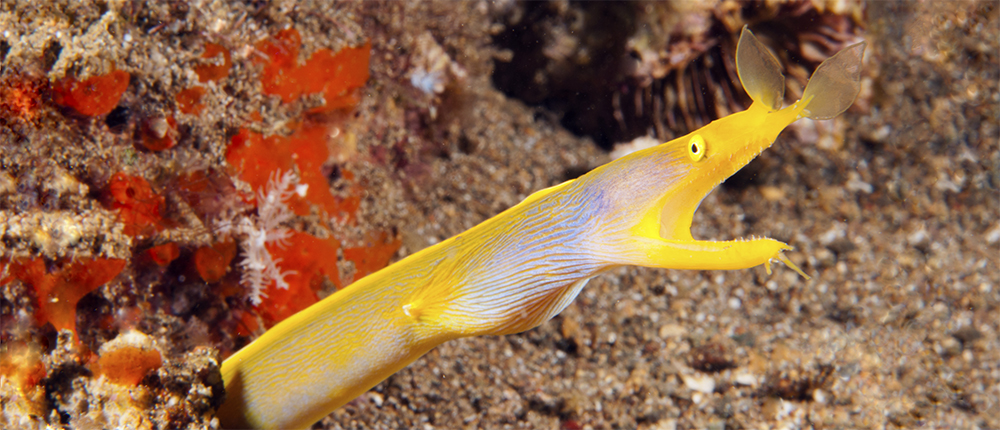Eel Appeal
An introduction to Wakatobi’s slippery, slithering residents of the reefs
The reefs of Wakatobi are packed with unique and colorful marine life, providing divers and snorkelers with endless opportunities to hunt for that rare and special find. But even if you fail to locate that one-of-a-kind rarity, there are always the eels. Spend a few minutes wandering around most any dive site in the area, and in fairly short order you are likely to see the distinctive profile of an eel poking its snout out of a sheltering crevice or burrow. It’s easy to take these sightings for granted, but as with most things on the reef, the closer you look, and the more you understand the subject, the more fascinating the encounter.
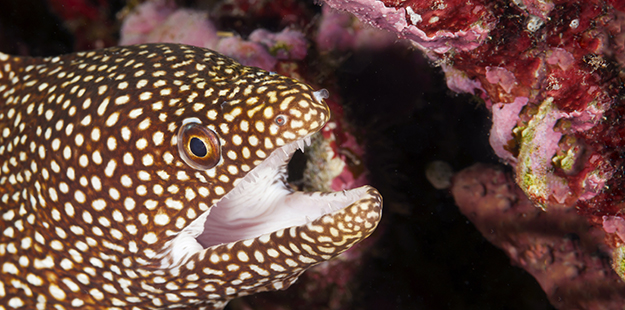
Moray eels, such as this spotted variety, are solitary animals, relying mostly on an excellent sense of smell to locate their meals. Photo by Wakatobi Resort
That’s a Moray
With more than 200 species of the Muraenidae family living in tropical waters world wide, it’s no wonder that the eels divers are most familiar with are the morays. The waters of Wakatobi are home to more than two dozen varieties, and those most likely to be seen on area dive sites include the giant moray, snowflake moray, white-eyed moray, whitemouth moray, yellowmargin moray, fimbriated moray and zebra moray. While some of these species maintain a relatively bland brown or gray coloration, others sport stripes, spots, freckles and other intricate color patterns.
Coloration aside, most all morays have common features that include large heads with wide mouths and small eyes located well forward. There’s no mistaking the razor-sharp teeth, as morays typically keep their dentition on display. This showing of the teeth isn’t a treat, but rather a necessity of their physiology. Morays lack the bony gill covers that other fish use to force water over their internal gill chambers. Instead, these eels must constantly open and close their mouths to force water over their gills.
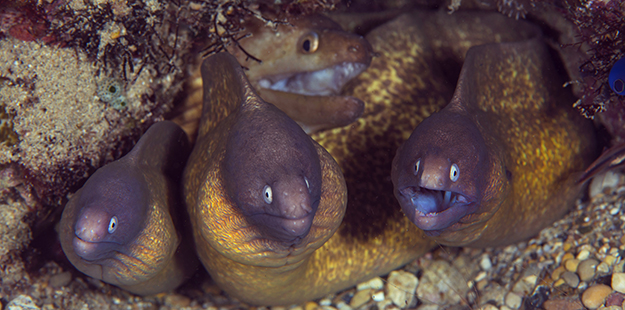
Morays are the only known animal to have pharyngeal jaws, a second set, which are distinct from their primary oral jaws, enabling them to more efficiently grab and swallow prey. Photo by Nigel Wade
Take a closer look—but keep your fingers well away—and you may notice a second set of teeth behind the first row. Morays are the only known animal to have what are known as pharyngeal jaws. When the eel latches on to a meal, these secondary jaws are thrust forward to grab and drag prey down into the throat.
Moray eels have very poor eyesight, and rely mostly on an excellent sense of smell to locate their meals. This is less of a disadvantage than one might think, because morays hunt primarily at night. That’s why you are more likely to see them out and slithering across the reef during a night dive. To help with the slithering, these eels secrete thick coats of mucous that help lubricate their skin and protect it from abrasion as the animal moves through the crevices of the reef. Because this slime layer doesn’t protect the eel from parasites, morays are frequent customers for cleaner shrimp. If you happen across a moray getting a grooming, it’s worth hanging around for a few minutes to watch the tiny shrimp perform their services.

Known as protandric hermaphrodites, ribbon eels begin life as males, then change sexes as they grow. Photo by Wakatobi Resort
A blue-ribbon prize
Ribbon eel, leaf-nosed moray or bernis eel. It’s three names for the same animal, and this close relative of the moray is a prized find and favorite subject for underwater photographers. With it’s extended flaring nostrils and gaping spiked jaw, this eel conjures images of a mythical dragon, and provides an interesting profile for portraits. Most images of a ribbon eel show an animal with a bright blue body and yellow jaws and nostrils. This prompts many to call this species a blue ribbon eel. But in fact, this vivid coloration is on display only during one of the eel’s three lifecycle changes.

Juvenile ribbon eels have black bodies with a yellow dorsal fin, and can sometimes be found slithering about the reef on their own. They’ll grow to an overall length of approx 1m (3.3 ft), and have a life span of up to twenty years. Photo by Wakatobi Resort
Ribbon eels are known as protandric hermaphrodites, meaning they begin life as males, then change sexes as they grow. Juveniles have black bodies with a yellow dorsal fin. As they mature and become males, ribbon eels transition to the bright blue color that photographers love. At this point, the eel is usually between 60 to 90 centimeters in length. As they grow beyond the meter mark, ribbon eels transition into females with yellow bodies.
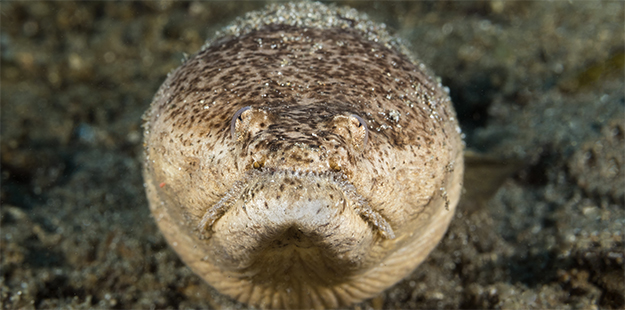
The stargazer snake eel is typically found burrowed into the sand tail-first until only its beady eyes and the top of its snout are visible. Photo by Walt Stearns
Snakes in the sand
Divers might not realize that there are quite a few members of the snake eel family inhabiting the waters of Wakatobi. That’s because, unlike their moray cousins, these bottom dwellers prefer to remain hidden. Snake eels are burrowers, usually living on sand or mud bottoms where they can lurk below the sea floor, with only their nostrils and eyes exposed. Staying buried provides protection from would-be predators and concealment to launch strike attacks on passing prey such as crustaceans and small fish. Of the species that perform sneak attacks, the most formidable in appearance is the stargazer snake eel. Divers and snorkelers with a keen eye may spot one of these eels buried in the sand flats of the House Reef, showing little more than its beady eyes and jagged teeth.
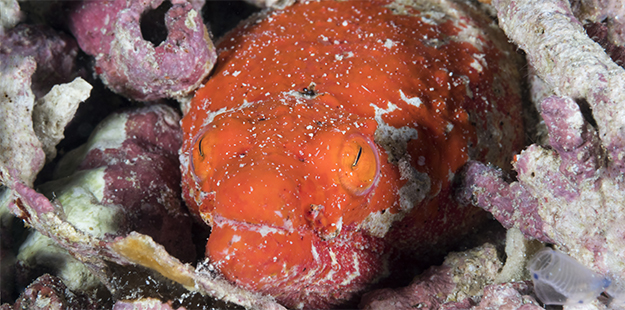
The reptilian snake eel is a burrower, typically lurking below the sea floor, with only its nostrils and eyes exposed. Photo by Walt Stearns
The giant snake eel displays an equally threatening countenance, while species such as the napoleon, tiger and harlequin snake eel are more benign in appearance, and showcase brighter and more intricate color patterns. The harlequin is sometimes known as the banded snake eel, because it’s white and black striped body mimics the patterns of a banded sea snake, giving the eel immunity from predators who mistake it for the toxic reptile.


